Tuesday, 13 July 2010: Ghent, walking tour and posters
Written 16 July 2010
Breakfast in the hotel again, as we still couldn't find anywhere else. I then attended the morning sessions as usual (and spend the time working on this blog), but in the afternoon, a walking tour of Ghent had been laid on for the "accompanying persons," for which I was signed up. It started at 1:30 p.m., only an hour after the end of the morning session (and well before resumption of the afternoon session, so by prearrangement with David, I ducked out a paper or two early, so as to have time to find lunch on my own.
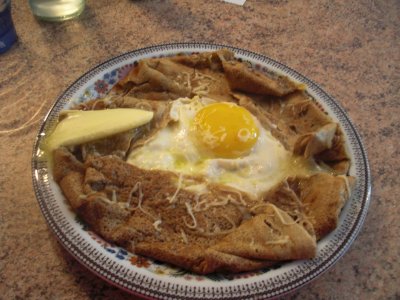 The tour was scheduled to be over before the end of the afternoon session, so I left my computer bag with the friendly people at the registration desk and went across the street to the "Gwenola Crêperie Bretonne. I had admired its menu earlier, but David is not enthusiastic about Breton crêpes because he can't digest the buckwheat with which savory crêpes are always made in Brittany. I ordered a crêpe with cheese and egg. Note the piece of butter at the left, melting where it touched the hot plate. When it arrived, the waitress grabbed an unlabeled shaker full of something dark-colored and put it on my table as well. When she put it down, I thought she said it was pepper, so after tasting the egg, I sprinkled a little on. Wow, the "pepper" was really good, so I added a bunch more. Only later, after seeing the label on someone else's shaker and sniffing my own, did I figure out that it was filled with celery salt. I'll definitely have to try that at home!
The tour was scheduled to be over before the end of the afternoon session, so I left my computer bag with the friendly people at the registration desk and went across the street to the "Gwenola Crêperie Bretonne. I had admired its menu earlier, but David is not enthusiastic about Breton crêpes because he can't digest the buckwheat with which savory crêpes are always made in Brittany. I ordered a crêpe with cheese and egg. Note the piece of butter at the left, melting where it touched the hot plate. When it arrived, the waitress grabbed an unlabeled shaker full of something dark-colored and put it on my table as well. When she put it down, I thought she said it was pepper, so after tasting the egg, I sprinkled a little on. Wow, the "pepper" was really good, so I added a bunch more. Only later, after seeing the label on someone else's shaker and sniffing my own, did I figure out that it was filled with celery salt. I'll definitely have to try that at home!
As I was eating, three American colleagues (the "Alabama contingent") came in and joined me and, after a glance at my plate, ordered the same thing. While they ate their crêpes, I ordered an ice cream (a "parfait praliné au caramel"; vanilla ice cream, "praline" ice cream, and caramel sauce). At 1:30 p.m., I rendez-voused with the tour group (together with one of the Alabama folks), and we set out to learn all about Ghent. The tour guide was running late, so our "minder" from the conference (who came along on the whole tour, to help the guide keep us together and to keep track of everyone) led us up the square in front of Sint-Baafs (Saint Bavo's) cathedral to meet her halfway.
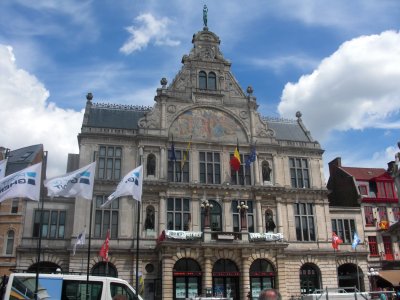
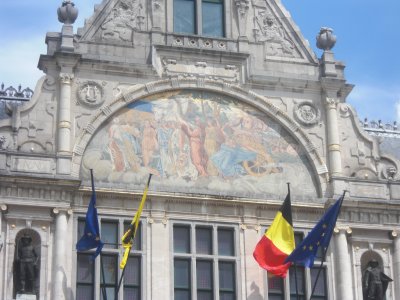 The square is also in front of the central theater of Ghent, shown at the left. Over its door is this beautiful semicircular fresco (or perhaps mosaic?). The guide met us there, and we started with a (too rapid!) visit to Sint-Baafskathedraal. David and I had seen the famous retable "Adoration of the Mystic Lamb" by Hubert and Jan van Eyck (finished, after 12 years' work, in 1432) when we were here in 1983 and had stood transfixed, our jaws on the floor, for a good hour. It's breathtaking and arguably our favorite work of art in the world. An improvement since our visit is the advent of audioguides; a disimprovement is that, just now, the retable is in pieces, undergoing restoration. Tickets to see it therefore include both admission to the glass window looking into the restoration studio, where you can see the actual panels being photographed and worked on, and to the life-size photographic reproduction now on display in the side chapel where the work rightly belongs (the one for which it was commissioned). In the chapel, the admission includes use of an audioguide (your choice of language) that gives very complete explanations, history, and related information. In addition, in another side chapel is a small (ca. 3-foot) model that you can actually touch, open and close, etc. (the original is quite large; the Adam and Eve that flank the upper row of panels are more or less life size). Elsewhere still, one can see the two replacement panels commissioned by a prudish bishop during the Victorian era in which Adam and Eve are clad in animal skins.
The square is also in front of the central theater of Ghent, shown at the left. Over its door is this beautiful semicircular fresco (or perhaps mosaic?). The guide met us there, and we started with a (too rapid!) visit to Sint-Baafskathedraal. David and I had seen the famous retable "Adoration of the Mystic Lamb" by Hubert and Jan van Eyck (finished, after 12 years' work, in 1432) when we were here in 1983 and had stood transfixed, our jaws on the floor, for a good hour. It's breathtaking and arguably our favorite work of art in the world. An improvement since our visit is the advent of audioguides; a disimprovement is that, just now, the retable is in pieces, undergoing restoration. Tickets to see it therefore include both admission to the glass window looking into the restoration studio, where you can see the actual panels being photographed and worked on, and to the life-size photographic reproduction now on display in the side chapel where the work rightly belongs (the one for which it was commissioned). In the chapel, the admission includes use of an audioguide (your choice of language) that gives very complete explanations, history, and related information. In addition, in another side chapel is a small (ca. 3-foot) model that you can actually touch, open and close, etc. (the original is quite large; the Adam and Eve that flank the upper row of panels are more or less life size). Elsewhere still, one can see the two replacement panels commissioned by a prudish bishop during the Victorian era in which Adam and Eve are clad in animal skins.
The craftsmanship is just spectacular. Adam's foot, where he seems to step forward out of the frame, is used worldwide as a model of the use of foreshortening and perspective (the unsuccessful attempt to copy it in the "clothed" Adam is very revealing). The individual hairs on Adams legs and some of the tiny flowers in the lawn around the lamb (that panel includes 42 identifiable species of plants) were painted with brushes consisting of a single hair (like those used to paint portaits designed to fit inside lockets). And the stories of how the work has been split up, reunited, stolen, sold off, rescued, reunited again (it was a line item in the treaty of Versailles, for example) are hair-raising. One stolen panel is still missing (since 1934), and a police task force is still working on the case. Alas, all photography is forbidden inside the cathedral, but just Google-image "Het lam gods gent" for myriad photos, not one of which does the painting justice.
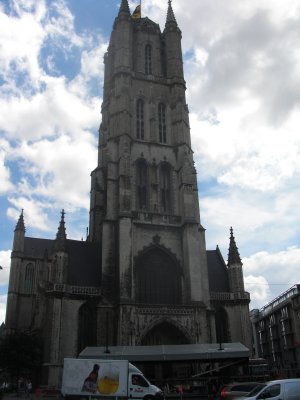
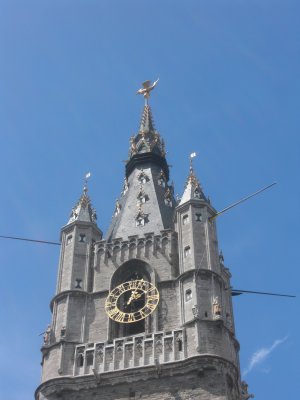 Right there in the center of the city, near the cathedral (tower at left), one can also see Sint-Niklaaskerk (St. Nicholas's church) and the Ghent town hall (tower at right), but Ghent is chock-a-block with picturesque and historical sites, so we set off walking, being shown something interesting on every street corner—the tour took over three hours, and the guide pointed off into the distance toward other things to see that we didn't have time for! At one point, we walked past the building thought to have been the van Eycks' studio (the street view from it can be seen out one of the windows in the "annunciation" panels of the closed retable; the tower of Sint-Niklaas is on the horizon behind the mystic lamb). On our way through a little square near the Aula (toward the studio), I spotted a café advertising breakfast and was delighted to see that it opened at 7:00 a.m.—eureka! The southernmost point of the tour was the flower market, empty when we were there, where the newly restored stone paving is inlaid with giant brass plant parts. In each one, the name of the plant is hidden in the pattern of the veins of the leaf; the fig leaf on which we stood (its veins read "fijge") was about three meters across.
Right there in the center of the city, near the cathedral (tower at left), one can also see Sint-Niklaaskerk (St. Nicholas's church) and the Ghent town hall (tower at right), but Ghent is chock-a-block with picturesque and historical sites, so we set off walking, being shown something interesting on every street corner—the tour took over three hours, and the guide pointed off into the distance toward other things to see that we didn't have time for! At one point, we walked past the building thought to have been the van Eycks' studio (the street view from it can be seen out one of the windows in the "annunciation" panels of the closed retable; the tower of Sint-Niklaas is on the horizon behind the mystic lamb). On our way through a little square near the Aula (toward the studio), I spotted a café advertising breakfast and was delighted to see that it opened at 7:00 a.m.—eureka! The southernmost point of the tour was the flower market, empty when we were there, where the newly restored stone paving is inlaid with giant brass plant parts. In each one, the name of the plant is hidden in the pattern of the veins of the leaf; the fig leaf on which we stood (its veins read "fijge") was about three meters across.
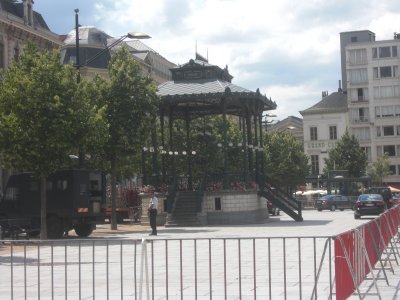 The flower-market square will be devoted to rock music during the Ghent festival. Happily, it already has a bandstand, so no temporary stage had to be erected there. It's just cordonned off for the moment with metal crowd fences.
The flower-market square will be devoted to rock music during the Ghent festival. Happily, it already has a bandstand, so no temporary stage had to be erected there. It's just cordonned off for the moment with metal crowd fences.
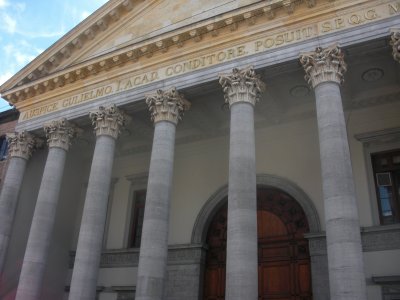 Heading back the other way, we stopped in at Daskalidès chocolaterie for a tasting (also included in the tour)—excellent. We paused on the steps of the Aula at that point to call the role, as we seemed to be missing someone, and while she caught up, the guide told us about a piece of outdoor art perpetrated during a recent street-art festival—the artist covered the columns of the Aula (shown at left)entirely in sliced raw ham, held in place by thin wire netting. The result apparently looked exactly like porphyry, but within a day or two in the sun, it didn't smell very good and the melting fat was staining the steps as well as the columns. The columns have since been cleaned, so no harm done that way, but public sentiment was strongly against the waste of food involved, so such installations have been ruled out for the future.
Heading back the other way, we stopped in at Daskalidès chocolaterie for a tasting (also included in the tour)—excellent. We paused on the steps of the Aula at that point to call the role, as we seemed to be missing someone, and while she caught up, the guide told us about a piece of outdoor art perpetrated during a recent street-art festival—the artist covered the columns of the Aula (shown at left)entirely in sliced raw ham, held in place by thin wire netting. The result apparently looked exactly like porphyry, but within a day or two in the sun, it didn't smell very good and the melting fat was staining the steps as well as the columns. The columns have since been cleaned, so no harm done that way, but public sentiment was strongly against the waste of food involved, so such installations have been ruled out for the future.
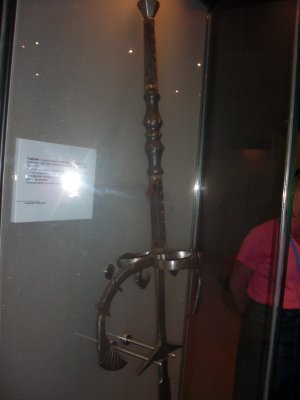
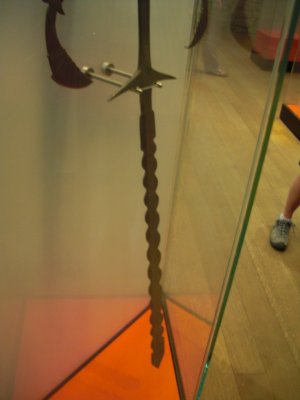 At the northernmost point of the tour, we visited the Grafensteen castle and its museums of weapons and instruments of torture. Again, all the admission charges were included in the tour. We saw the usual pikes with various points and hooks, designed for hooking armored knights off their horses, but one of the most interesting (and perhaps creepiest) weapons was this two-handed, saw-toothed, blunt sword, photographed in two pieces (it stood about five feet tall). It was designed as a sort of "can opener" to be wedged between the armor plates of a fallen knight, so that he could be pried open and placed at the mercy of enemy swordsmen with more conventional sharpened weapons.
At the northernmost point of the tour, we visited the Grafensteen castle and its museums of weapons and instruments of torture. Again, all the admission charges were included in the tour. We saw the usual pikes with various points and hooks, designed for hooking armored knights off their horses, but one of the most interesting (and perhaps creepiest) weapons was this two-handed, saw-toothed, blunt sword, photographed in two pieces (it stood about five feet tall). It was designed as a sort of "can opener" to be wedged between the armor plates of a fallen knight, so that he could be pried open and placed at the mercy of enemy swordsmen with more conventional sharpened weapons.
The torture instruments were, needless to say, fiendish and imaginative—an almost frightening commentary on human ingenuity! Recurring themes were, of course, thumbscrews, sharp pointy things, stretching apparatus, branding equipment, and cages for enforcing uncomfortable positions. The museum also included humiliation devices, like stocks, for minor offenses as well as apparatus for simple restraint, as lunatics were among those confined there. They weren't intentionally tortured, but some were chained or strapped down of clad in heavy canvas straight-jackets.
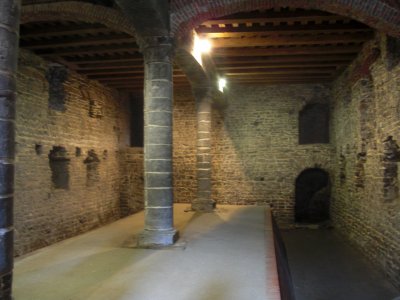
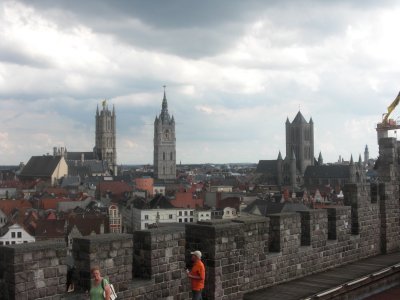 In the course of the tour, we started in the cellars of the castle, in the original keep (left), then climbed all the way to the top, where the platforms provided wonderful views over the city. At the right, you can see the three famous towers of Ghent (left to right, Sint-Baafs, the town hall, and Sint-Niklaas); at the extreme right, you can see a little of a less famous tower—the inevitable construction crane.
In the course of the tour, we started in the cellars of the castle, in the original keep (left), then climbed all the way to the top, where the platforms provided wonderful views over the city. At the right, you can see the three famous towers of Ghent (left to right, Sint-Baafs, the town hall, and Sint-Niklaas); at the extreme right, you can see a little of a less famous tower—the inevitable construction crane.
We got back to the Aula, footsore but well informed, about half an hour late, just as the afternoon session was breaking up.
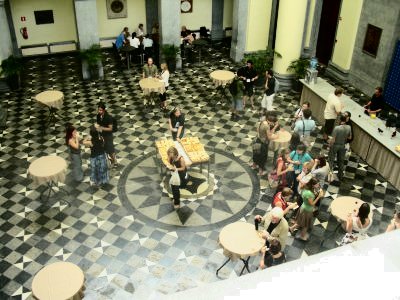
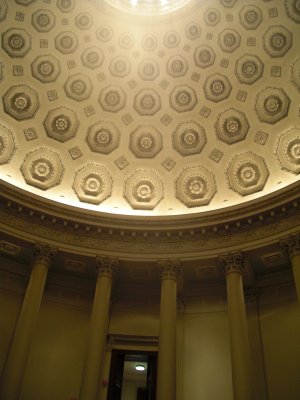 The official poster session began a few minutes later, and to save time, the conference organizers had light supper catered in. The posters (130 of them!) had been on display since the beginning if the meeting, but this was our chance to talk to the authors, who stood by their presentations to explain and answer questions. I got this shot of the foyer (site of all the breaks, receptions, and other catered events) from its second-floor balcony, where the posters were displayed. (At the right is a view I finally managed to get of the rotunda ceiling above the main auditorium, where the talks were presented.)
The official poster session began a few minutes later, and to save time, the conference organizers had light supper catered in. The posters (130 of them!) had been on display since the beginning if the meeting, but this was our chance to talk to the authors, who stood by their presentations to explain and answer questions. I got this shot of the foyer (site of all the breaks, receptions, and other catered events) from its second-floor balcony, where the posters were displayed. (At the right is a view I finally managed to get of the rotunda ceiling above the main auditorium, where the talks were presented.)
In the photo of the foyer, you can see the trays of sandwiches provided for our refreshment during the poster session. They were replenished regularly, and others were laid out on the bar at the right, where wine, beer, orange juice, and water were freely dispensed. The sandwiches were excellent and varied. I saw some filled with goat cheese, tomato, and lettuce and others were Swiss cheese, carrot, and lettuce. David went straight for the smoked salmon, butter, and onion, so took the other fish option, which I expected to be herring (in season just now) but which the caterer identified later as butter, cold-smoked smoked halibut, and onion—it was great (consensus top choice among those I talked to; David even ate one)! I then had a salmon sandwich—very good but not as good as the halibut—then, later, another half of the halibut.
I followed David around to some of the posters that interested him. After he discussed the content with the authors, I offered to help with the English, although most were really very well written, even by nonnative speakers of English. I found only one real problem—someone had used the word "specious" but actually meant "speciose"; MS Word's spell checker would not catch that error and probably doesn't even know the word "speciose."
The posters varied widely, of course, in quality of both content and design, although the overall standard was quite high. I did not envy the committee charged with choosing the best ones. Our favorite was one by a young South American woman that included spectacular composite photographs of copepods, in glowing amber on a black background, that were generated by means of software that took a long series of confocal photos of the same individual, at different focal depths—essentially optical cross sections—then merged them seemlessly into incredibly detailed composite views. She said that it took some practice but that, once she knew what she was doing, she could process an individual a day. Even more exciting, although the concept has not yet been rigorously tested, one should be able to sequence the genome of the same individual used to produce the image, a possibility that David is very excited about. In addition to the "flat" photos on her poster, she had posted, on a pillar nearby, a pair of large 3D photos (dorsal and lateral views of one copepod, each perhaps one by two feet) and provided the little paper red-and-green 3D glasses for viewing them. Wow! Everyone (including me!) who put on the glasses exclaimed and stepped back as the image leaped into three dimensions. Spectacular!
previous entry
List of Entries
next entry
 The tour was scheduled to be over before the end of the afternoon session, so I left my computer bag with the friendly people at the registration desk and went across the street to the "Gwenola Crêperie Bretonne. I had admired its menu earlier, but David is not enthusiastic about Breton crêpes because he can't digest the buckwheat with which savory crêpes are always made in Brittany. I ordered a crêpe with cheese and egg. Note the piece of butter at the left, melting where it touched the hot plate. When it arrived, the waitress grabbed an unlabeled shaker full of something dark-colored and put it on my table as well. When she put it down, I thought she said it was pepper, so after tasting the egg, I sprinkled a little on. Wow, the "pepper" was really good, so I added a bunch more. Only later, after seeing the label on someone else's shaker and sniffing my own, did I figure out that it was filled with celery salt. I'll definitely have to try that at home!
The tour was scheduled to be over before the end of the afternoon session, so I left my computer bag with the friendly people at the registration desk and went across the street to the "Gwenola Crêperie Bretonne. I had admired its menu earlier, but David is not enthusiastic about Breton crêpes because he can't digest the buckwheat with which savory crêpes are always made in Brittany. I ordered a crêpe with cheese and egg. Note the piece of butter at the left, melting where it touched the hot plate. When it arrived, the waitress grabbed an unlabeled shaker full of something dark-colored and put it on my table as well. When she put it down, I thought she said it was pepper, so after tasting the egg, I sprinkled a little on. Wow, the "pepper" was really good, so I added a bunch more. Only later, after seeing the label on someone else's shaker and sniffing my own, did I figure out that it was filled with celery salt. I'll definitely have to try that at home!
 The square is also in front of the central theater of Ghent, shown at the left. Over its door is this beautiful semicircular fresco (or perhaps mosaic?). The guide met us there, and we started with a (too rapid!) visit to Sint-Baafskathedraal. David and I had seen the famous retable "Adoration of the Mystic Lamb" by Hubert and Jan van Eyck (finished, after 12 years' work, in 1432) when we were here in 1983 and had stood transfixed, our jaws on the floor, for a good hour. It's breathtaking and arguably our favorite work of art in the world. An improvement since our visit is the advent of audioguides; a disimprovement is that, just now, the retable is in pieces, undergoing restoration. Tickets to see it therefore include both admission to the glass window looking into the restoration studio, where you can see the actual panels being photographed and worked on, and to the life-size photographic reproduction now on display in the side chapel where the work rightly belongs (the one for which it was commissioned). In the chapel, the admission includes use of an audioguide (your choice of language) that gives very complete explanations, history, and related information. In addition, in another side chapel is a small (ca. 3-foot) model that you can actually touch, open and close, etc. (the original is quite large; the Adam and Eve that flank the upper row of panels are more or less life size). Elsewhere still, one can see the two replacement panels commissioned by a prudish bishop during the Victorian era in which Adam and Eve are clad in animal skins.
The square is also in front of the central theater of Ghent, shown at the left. Over its door is this beautiful semicircular fresco (or perhaps mosaic?). The guide met us there, and we started with a (too rapid!) visit to Sint-Baafskathedraal. David and I had seen the famous retable "Adoration of the Mystic Lamb" by Hubert and Jan van Eyck (finished, after 12 years' work, in 1432) when we were here in 1983 and had stood transfixed, our jaws on the floor, for a good hour. It's breathtaking and arguably our favorite work of art in the world. An improvement since our visit is the advent of audioguides; a disimprovement is that, just now, the retable is in pieces, undergoing restoration. Tickets to see it therefore include both admission to the glass window looking into the restoration studio, where you can see the actual panels being photographed and worked on, and to the life-size photographic reproduction now on display in the side chapel where the work rightly belongs (the one for which it was commissioned). In the chapel, the admission includes use of an audioguide (your choice of language) that gives very complete explanations, history, and related information. In addition, in another side chapel is a small (ca. 3-foot) model that you can actually touch, open and close, etc. (the original is quite large; the Adam and Eve that flank the upper row of panels are more or less life size). Elsewhere still, one can see the two replacement panels commissioned by a prudish bishop during the Victorian era in which Adam and Eve are clad in animal skins.
 Right there in the center of the city, near the cathedral (tower at left), one can also see Sint-Niklaaskerk (St. Nicholas's church) and the Ghent town hall (tower at right), but Ghent is chock-a-block with picturesque and historical sites, so we set off walking, being shown something interesting on every street corner—the tour took over three hours, and the guide pointed off into the distance toward other things to see that we didn't have time for! At one point, we walked past the building thought to have been the van Eycks' studio (the street view from it can be seen out one of the windows in the "annunciation" panels of the closed retable; the tower of Sint-Niklaas is on the horizon behind the mystic lamb). On our way through a little square near the Aula (toward the studio), I spotted a café advertising breakfast and was delighted to see that it opened at 7:00 a.m.—eureka! The southernmost point of the tour was the flower market, empty when we were there, where the newly restored stone paving is inlaid with giant brass plant parts. In each one, the name of the plant is hidden in the pattern of the veins of the leaf; the fig leaf on which we stood (its veins read "fijge") was about three meters across.
Right there in the center of the city, near the cathedral (tower at left), one can also see Sint-Niklaaskerk (St. Nicholas's church) and the Ghent town hall (tower at right), but Ghent is chock-a-block with picturesque and historical sites, so we set off walking, being shown something interesting on every street corner—the tour took over three hours, and the guide pointed off into the distance toward other things to see that we didn't have time for! At one point, we walked past the building thought to have been the van Eycks' studio (the street view from it can be seen out one of the windows in the "annunciation" panels of the closed retable; the tower of Sint-Niklaas is on the horizon behind the mystic lamb). On our way through a little square near the Aula (toward the studio), I spotted a café advertising breakfast and was delighted to see that it opened at 7:00 a.m.—eureka! The southernmost point of the tour was the flower market, empty when we were there, where the newly restored stone paving is inlaid with giant brass plant parts. In each one, the name of the plant is hidden in the pattern of the veins of the leaf; the fig leaf on which we stood (its veins read "fijge") was about three meters across. The flower-market square will be devoted to rock music during the Ghent festival. Happily, it already has a bandstand, so no temporary stage had to be erected there. It's just cordonned off for the moment with metal crowd fences.
The flower-market square will be devoted to rock music during the Ghent festival. Happily, it already has a bandstand, so no temporary stage had to be erected there. It's just cordonned off for the moment with metal crowd fences. Heading back the other way, we stopped in at Daskalidès chocolaterie for a tasting (also included in the tour)—excellent. We paused on the steps of the Aula at that point to call the role, as we seemed to be missing someone, and while she caught up, the guide told us about a piece of outdoor art perpetrated during a recent street-art festival—the artist covered the columns of the Aula (shown at left)entirely in sliced raw ham, held in place by thin wire netting. The result apparently looked exactly like porphyry, but within a day or two in the sun, it didn't smell very good and the melting fat was staining the steps as well as the columns. The columns have since been cleaned, so no harm done that way, but public sentiment was strongly against the waste of food involved, so such installations have been ruled out for the future.
Heading back the other way, we stopped in at Daskalidès chocolaterie for a tasting (also included in the tour)—excellent. We paused on the steps of the Aula at that point to call the role, as we seemed to be missing someone, and while she caught up, the guide told us about a piece of outdoor art perpetrated during a recent street-art festival—the artist covered the columns of the Aula (shown at left)entirely in sliced raw ham, held in place by thin wire netting. The result apparently looked exactly like porphyry, but within a day or two in the sun, it didn't smell very good and the melting fat was staining the steps as well as the columns. The columns have since been cleaned, so no harm done that way, but public sentiment was strongly against the waste of food involved, so such installations have been ruled out for the future.

 At the northernmost point of the tour, we visited the Grafensteen castle and its museums of weapons and instruments of torture. Again, all the admission charges were included in the tour. We saw the usual pikes with various points and hooks, designed for hooking armored knights off their horses, but one of the most interesting (and perhaps creepiest) weapons was this two-handed, saw-toothed, blunt sword, photographed in two pieces (it stood about five feet tall). It was designed as a sort of "can opener" to be wedged between the armor plates of a fallen knight, so that he could be pried open and placed at the mercy of enemy swordsmen with more conventional sharpened weapons.
At the northernmost point of the tour, we visited the Grafensteen castle and its museums of weapons and instruments of torture. Again, all the admission charges were included in the tour. We saw the usual pikes with various points and hooks, designed for hooking armored knights off their horses, but one of the most interesting (and perhaps creepiest) weapons was this two-handed, saw-toothed, blunt sword, photographed in two pieces (it stood about five feet tall). It was designed as a sort of "can opener" to be wedged between the armor plates of a fallen knight, so that he could be pried open and placed at the mercy of enemy swordsmen with more conventional sharpened weapons.
 In the course of the tour, we started in the cellars of the castle, in the original keep (left), then climbed all the way to the top, where the platforms provided wonderful views over the city. At the right, you can see the three famous towers of Ghent (left to right, Sint-Baafs, the town hall, and Sint-Niklaas); at the extreme right, you can see a little of a less famous tower—the inevitable construction crane.
In the course of the tour, we started in the cellars of the castle, in the original keep (left), then climbed all the way to the top, where the platforms provided wonderful views over the city. At the right, you can see the three famous towers of Ghent (left to right, Sint-Baafs, the town hall, and Sint-Niklaas); at the extreme right, you can see a little of a less famous tower—the inevitable construction crane.
 The official poster session began a few minutes later, and to save time, the conference organizers had light supper catered in. The posters (130 of them!) had been on display since the beginning if the meeting, but this was our chance to talk to the authors, who stood by their presentations to explain and answer questions. I got this shot of the foyer (site of all the breaks, receptions, and other catered events) from its second-floor balcony, where the posters were displayed. (At the right is a view I finally managed to get of the rotunda ceiling above the main auditorium, where the talks were presented.)
The official poster session began a few minutes later, and to save time, the conference organizers had light supper catered in. The posters (130 of them!) had been on display since the beginning if the meeting, but this was our chance to talk to the authors, who stood by their presentations to explain and answer questions. I got this shot of the foyer (site of all the breaks, receptions, and other catered events) from its second-floor balcony, where the posters were displayed. (At the right is a view I finally managed to get of the rotunda ceiling above the main auditorium, where the talks were presented.)